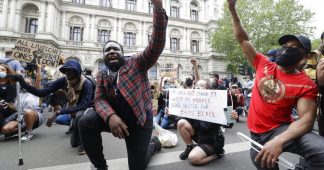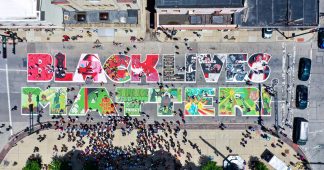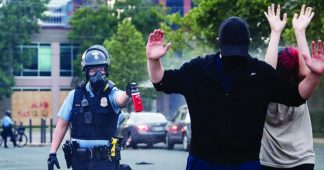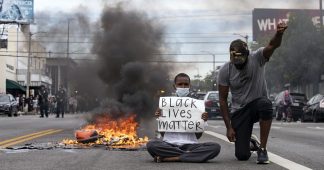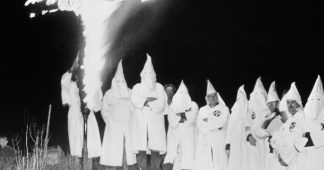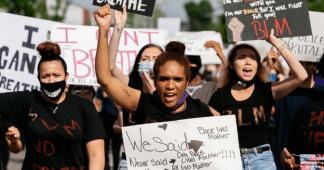June 8, 2020
“We ourselves live in a pretty sick society that seems incapable of feelings of sisterhood, brotherhood, solidarity”
An Email interview with Arundhati Roy
DC: How do we support the movement in the US and how does one show solidarity with people protesting in India?
I’m assuming that you mean the massive protests that have erupted over the cold-blooded killing of George Floyd—the latest in a series of killings of African Americans by white American police. I would say that the best way of supporting that movement is to understand where it comes from, first of all. The history of slavery, racism, the civil rights movement—its successes and failures. The crude as well as subtle ways in which African Americans in North America are brutalized, incarcerated, disenfranchised within the framework of “democracy”. And to understand the role that the majority of the Indian community in the US has played in all of this. Who has it traditionally aligned itself with? The answers will tell us a lot about our own society. We can only support that really grand show of rage across cultures and communities that is happening there, if we address our own values and actions with some degree of honesty. We ourselves live in a pretty sick society that seems incapable of feelings of sisterhood, brotherhood, solidarity…
DC: Are the ideologies and practices of the Ku Klux Klan in the US and the caste Hindus organising cow vigilantes in India, similar?
Of course there are similarities. The difference is that the Ku Klux Klan had a somewhat different sense of theatre when they conducted their killings. Like the RSS today, in its time, the Klan used to be amongst the most influential organizations in the US. Its members had penetrated all public institutions including the police and the judiciary. Klan killings were never just killings—they were ritual performances meant to convey terror and teach lessons. This is as true of the lynching of Black people by the KKK as it is of the lynching of Dalits and Muslims by Hindu vigilantes. Remember Surekha Bhotmange and her family? Of course Surekha Bhotmange and George Lloyd are very different people with different struggles. She and her family were massacred by people from her own village. The cop Derek Chauvin murdered George Floyd with a great sense of theatre. He had one hand in his pocket and his knee on Floyd’s neck. He had help. He had other cops keeping guard. He had an audience. He knew he was being filmed. He did it anyway. Because he believed he had protection and impunity. At the moment White supremacists and Hindu supremacists both have sympathisers (to put it politely)—occupying high office. So both are on a roll.
DC: We see Indians trending #blacklivesmatter but in this very country we find continuous attacks on Blacks? How do Indians see Blacks or what stereotype do we Indians have of them?
Look at the Indian obsession with fair skin. It is one of the most sickening things about us. If you watch Bollywood movies you’d imagine India was a country of white folks. Indian racism towards Black people is almost worse than white peoples’ racism. It’s unbelievable. I’ve seen it happen on the streets when I’ve been with Black friends. And sometimes it comes from people whose skin colour is really no different! Rarely have I been so enraged and ashamed. That racism has manifested in outright attacks. In 2014, soon after the Aam Aadmi Party won a massive mandate in the Delhi elections, the Law Minister Somnath Bharti led a group of people on a midnight raid, a group of Congolese and Ugandan women were physically attacked and humiliated in Khirki for being involved with “immoral and illegal activities”. In 2017 African students were attacked and beaten by a vigilante mob in Greater NOIDA, charged with selling drugs. But racism in India is vast and varied. Who can forget the BJP Member of Parliament Tarun Vijay’s defense of racism after the NOIDA attack— “If we were racist, why would the entire South — you know the Tamils, you know Kerala, Karnataka and Andhra — why do we live with them?” Why do they live with us? He should tell us black South Indian folks. I’d like to know his reasons.
DC: When African Americans argue #blacklivesmatter, Asians argue #asianlivesmatter and whites argue #alllivesmatter…
That is a sly way of draining the politics out of what is being said by resorting to meaningless truisms. Asians and Whites are not being murdered, incarcerated, disenfranchised and impoverished in the US in the way African Americans are. Ever since slavery in the US ended there has been a concerted effort to violently hobble, hold down and enslave African Americans in other ways that appear to fit into the social contract and legal framework of a democracy. The international story of American Imperialism and war—the genocide in Vietnam, Japan, Iraq, Afghanistan is a separate story… I don’t think that is what #asianlivesmatter and #alllivesmatter are referring to.
DC: When Dalits say #dalitlivesmatter, does it not appropriate and undermine the struggle of Black people over centuries? Is the #dalitlivesmatter movement above racism?
Casteism and racism though they have different histories, are not different except that casteism claims some kind of divine mandate. So I think to say that #dalitlivesmatter appropriates the struggle of Black people over centuries is a bit harsh. I think it is an attempt to make common cause and to seek solidarity and some of the light from Black Lives Matter, a movement that by the very fact that it is taking place in the US, is more powerful, more visible than any other. In India, casteism has flown under the radar of international scrutiny for so long—a Project of Unseeing, helped along by even the best known, most respected intellectuals and academics.
Having said that—nobody is above racism. It takes different forms in different places. In South Africa for example, there is xenophobia from Black South Africans towards Nigerians and Africans from other African countries. And as we know, caste oppression, Brahminism, is practiced by every caste that oppresses the caste below it and that goes all the way down the ladder even within the political category of ‘Dalit’ as you yourself have experienced in your own struggles. Stare at anything long enough and it will always turn out to be more complicated than the rhetoric around it. But rhetoric is important. It provides a framework for people to organize their thoughts.
DC: Why are Blacks still stereotyped as drug peddlers, savages and cannibals in the India psyche and thereby in the Indian news and entertainment media?
Because we are a racist culture. Last year I saw a Malayalam film called Abrahaminde Santhathikal (The Sons of Abraham). The vicious, idiot-criminal villains were all Black Africans—and of course they were decimated by the Malayali superhero. There isn’t a community of Africans in Kerala—so the filmmaker imported them into a piece of fiction in order for this racism to be played out! This is not a State atrocity. This is society. This is people. Artists, filmmakers, actors, writers—South Indians who are mocked by North Indians for their dark skins in turn humiliating Africans for the very same reason. It’s like falling into a borewell with no bottom.
DC: Gandhi’s statue has been vandalised in the US protests, what could be the reason?
It’s hard to know. News reports say that the statue was vandalized and graffiti sprayed on it. But the photographs show the statue wrapped up, so one doesn’t know what the graffiti was. Was it part of the series of vandalization of Gandhi statues in Ghana and other countries done by people who are aware of Gandhi’s racist comments against Black Africans during his time in South Africa and his position on caste in India? Or was it done by people who wanted to express their disgust at the Indian Prime Minister and his great demonstrations of love for Trump… Howdy Modi, Namaste Trump etc. I don’t really know. It’s also true that many protestors tweeted photos of Gandhi as the source of their inspiration, their teacher and mentor in the tactics on non-violent civil disobedience. So Gandhi is present on those streets in many avatars.
DC: Why does the Indian government sponsor constructing Gandhi statues – the present statue was sponsored by Atal Bihari Vajpayee and many more statues in different African countries? The very Indian state promotes Gandhi statues abroad but in India it has the largest militarized zone and Indian society has become more intolerant..how does one understand this?
Gandhi, for good or for bad, is India’s greatest export. His message of non-violence has always sat very snugly with the Indian Government’s easy ability to resort to extreme violence and militarism in almost every part of this country. For them Gandhi is a tool. A utility. A smokescreen. Teargas maybe. Even socially, intellectually—to call oneself Gandhian does not seem to contradict the ease with which people— dominant castes—accept and practise caste, a system that we know can only continue to exist in a climate which permanently threatens violence—egregious physical violence— against transgressors. The hypocrisy goes unnoticed.
DC: Many Indians are sharing and celebrating the BLM movement pulling down the statue of the slave trade owner Edward Colston in Briston. But in India, we have Manu’s statue installed in front of the Rajasthan High Court and many more symbols that encourage casteism like “Brahmins only” houses ”. Yet we never show the slightest interest in even rejecting them, let alone pulling them down – what are your comments on this?
We live in a casteist, Hindu Nationalist State. We are very far away from the day when statues like these will be removed or pulled down. We are at the stage when they are being installed and celebrated. And sadly, even people who were once part of radical movements like the Dalit Panthers have joined hands with these new Rulers. The uprising we are seeing in the US today is the result of years of organizing, fighting, memorializing, of poetry, art, music, literature that has made the story of African Americans told by themselves, a living breathing presence that a new generation of Americans across the racial divide feel shame and fury about. This display of solidarity is an amazing thing.
DC: Do you think the lockdown and other state of exception acts in India were right measures to fight covid-19? Or were they hasty decisions, which have thrown the lives of so many into total havoc? Also, what is your opinion about the sudden “reopening/unlock” now?
The first Covid-19 case in India was reported on January 30th. Even after the WHO announced it was a pandemic on March 11th, the Ministry of Health said it was not a health emergency. When they should have shut international airports and quarantined international passengers they did not. Perhaps this was because Trump was coming. He arrived in the last week of February. Thousands of people flew in from the US to Mumbai and Ahmedabad to attend the Namastey Trump rally which hundreds of thousands attended. Now those two cities battered by Coronavirus. Is it a coincidence? How does one justify the stigmatization of the Tablighi Jamaat and the glorification of Namastey Trump? Instead of starting at the top, quarantining the Flying Classes the Government waited. And so the working classes paid the price. When the lockdown was announced with four hours’ notice there were 545 cases and 10 deaths. It was a cut-and-paste lockdown, imported from Italy and Spain who did it to impose “social distancing”. The calamity that this complete absence of planning has led to is a Crime Against Humanity. In India only the elite could physically distance themselves. The poor were physically compressed. In slums, in tiny homes, in unauthorized colonies. While Operation Vande Bharat flew Indians stranded in foreign countries home, millions of desperate working class people stranded in cities with no shelter, food or money, and no transport, began walking thousands of kilometres home to their villages. Hundreds of thousands were forcibly held in quarantine camps and then allowed to leave, jammed in buses and trains, carrying the virus with them. It showed that the Prime Minister, cunning as he is about how to win elections, has no clue about the country he runs. No clue, massive pride, no attempt to seek expert opinion. He locked down 1.38 billion people with four hours notice. Why? How? Because he could. Because everybody—politicians, bureaucrats, business people, industrialists and even his own colleagues in the BJP— is terrified of the consequences of speaking up. Everybody’s brains are either frozen with fear or preoccupied by how to please him, how to win favour.So we allowed him to destroy our country. To hammer us on both ends.
All through the lockdown the number of cases rose sharply. Now that the graph is like a steep rock cliff—we have over 200,000 cases—and the economy has collapsed completely, they have lifted the lockdown. Fortunately, a great majority of patients appear to be asymptomatic and the death toll is much lower than in the US and Europe—if we can trust the numbers. But millions are out of work. Hunger is setting in. What is happening in those villages that people have returned to? Casteism, feudalism, sexism… in moments of such fear, despair and want how will people manage?
But Modi still wants to buy Rafale fighter jets and spend twenty thousand crores on redesigning Delhi’s central vista—to leave an architectural legacy, I imagine. In the meantime, he will leave the management of the disaster to State Governments who he never consulted before locking down, but will now blame for the chaos.
He and his slave-ish media will sell this double-disaster to people as an achievement on his part. They’ve already started with their 72,000 LED screen virtual election campaign in Bihar. While people starve they have money for this. Already the narrative is quickly being shifted back to communalism. Now students from Jamia Milia Islamia and JNU who were brutally attacked by police and Hindutva thugs inside their universities are being arrested as conspirators in the Northeast Delhi violence, primarily an attack by Hindu vigilante mobs backed by police on Muslims! This is the Delhi version of Bhima-Koregaon. Between the two some of India’s best lawyers, activists, teachers and intellectuals are in jail. On crazy charges. As someone said, Modi can sell a comb to a bald man. If we buy it, we deserve it. We can keep combing our hairless heads, like fools.
DC: The government itself has introduced the Digital India project to “harness digital technologies” for “rapid economic growth and citizen empowerment”. The Aarogya Setu App and the MyGovCoronaHub have been introduced as part of this project. In your opinion, what exactly does the Indian state mean by harnessing digital technologies? Who constitutes the Indian citizen that it means to empower and in what ways? And who does it exclude, even if notionally, a majority of them are citizens?
The projected number of smartphone users in India by 2022 is projected to be 440 millon. That’s less than a third of the projected population. And now even children are expected to have smartphones for online learning. So these great plans for digital India exclude a majority of the population. The Apps you mention.. they have been introduced even though they are still half-baked and imperfect. This Bill Gates type of approach that believes technology, AI, etc. will solve the massive problems of health, education and poverty are dangerous. We need political solutions. Injustice, hunger, neo-racism, neo-Casteism, Islamophobia and ecological destruction are coded into neo-liberal Capitalism project. Apps and pretend-digital efficiency can’t and won’t solve the problem. Those are meant to stitch us into the Privatised Capitalist Surveillance State.
DC: Recently, Devika, a Dalit student committed suicide because she did not have the means to access online education, a mode that the Kerala government was trying to regularise. Technology, historically, has been considered a means to democratise society. However, in India, technology has become an occasion to further marginalise and exclude, as we see in the case of Devika, online education, etc. How can we handle this contradiction, in our specific context?
I think I have answered most of this question in reply to your previous question. Online education could become a disaster for children who come from non-privileged backgrounds. Devika killed herself because she saw herself falling into a deep well of exclusion. Because she did not have a smartphone and her family was too poor to repair the TV set. There are millions like her. But even for those who have smartphones—schools and university campuses and all that goes on outside of classrooms are just as important for young people as what goes on inside classrooms. Dalit, Adivasi and now increasingly Muslim students face great adversity in school and college campuses. But those battles must be fought. By all of us. Isolating ourselves online will be the most dangerous thing that can happen in our society. I deeply fear this idea of online education taking root—Governments that have long desired to disinvest from education and privatize it will try and take this route. We cannot allow it.
DC: Recently, you along with many international activists and academics launched an initiative called Progressive International. We already had Left internationalism and Black internationalism.., etc. But most of these attempts were disintegrated and somehow political imaginations are also nationalized and ethnicised. How will progressive internationalism move forward in the context of national populism and complete failure of world systems?
International initiatives are important. Because they give us perspective, understanding, a modicum of protection and paths of solidarity. Particularly now when in countries like ours, the political rhetoric is this ugly Hindu Nationalism. But internationalism cannot and must not ever replace local organizing and protest. That would be a big mistake. We have to fight our battles, and for the most part we will be alone. Nobody can help us.
DC: Global resistance movements are now demanding more radical and systemic change rather than gradual reformist optimistic actions. How do you see this in the Indian context where Hindu liberal secular public intellectuals still stress on their optimistic reformist political agenda under a Hindu Nazi Regime?
The short answer to that is that it is rare for people who have social/economic/intellectual stakes in the status quo to make revolution. They might want some re-painting or new plumbing. A little tweaking and tucking will do—but nothing more. So they keep the faith while almost every public institution in India fails the test of justice, egalitarianism and democracy. Many would flinch at your categorisation of this current regime as a Hindu Nazi Regime. But the fascist belief in the Master Race is not so distant from Brahminism and the concept of Bhudeva—of Brahmins being Gods on Earth. It’s not hard to see how the idea that some human beings are inherently superior or inferior to others by divine mandate slides easily into the fascist idea of a Master Race.
DC: In the ongoing anti-NRC-CAA-NPR movement, we are seeing how the Constitution and the Indian National flag are being foregrounded. Our question is specifically about the Constitution. Do you feel that the Constitution is being used to divert from the main Dalit-Bahujan-Muslim question in that it does not allow us to centre the identities of those who are at the frontlines of the movement? What according to you would be the implications of this?
Well this is complicated. For a set of very good reasons, people are being forced to paint themselves into a corner. The Indian Constitution of which Dr. Ambedkar was chair of the drafting committee is a document that was far ahead of its time given the condition of the society it was drafted for. It was the first time in India that morally and legally it was laid down in law that all human beings are equal and have equal rights. For a society as diverse as us in India, and one that practices caste— in which everybody, up and down the ladder except the very top and very bottom, has someone to oppress and someone to be oppressed by—this idea of equality, of constitutional morality was HUGE. For Dalits in particular it has become a Holy Book. Frozen in time. Ironically, Ambedkar himself was deeply disappointed by many aspects of the Constitution and believed that it should be a living document, that every generation ought to work towards improving it. But the need to protect it against constant attack by the Hindu Right has meant that the demands to change the Constitution were not progressive but regressive. So we have had to rally around it, to protect it. Those defending it, particularly now with the RSS in power have had to resort to a kind of Constitutionalism. 2019 was a shocking year. The blatant violation of the Constitution by abrogating Kashmir’s special status and enacting the anti-Muslim Citizenship Amendment Act implies that rather than re-write it and formally declare India a Hindu Nation, this government is going to just disregard it and behave as though we don’t have a Constitution at all. The demonization of Muslims as anti-National Pakistan sympathizers and terrorists, the vicious, dehumanizing language used against them by the mainstream media, the bias in courts and in police action and the outright bloodletting on the streets has meant that the only way protesting Muslims feel they can protect themselves on the street is to wave the Indian flag and recite the preamble of the Constitution. While Muslims are boycotted socially and economically, while mainstream TV channels openly broadcast #coronajehad and #humanbombs, while we hear horror stories of Muslims being denied medical care, both during the CAA protests as well as after Corona hit us, Kapil Mishra of the BJP struts around and Anurag Thakur who led the chant “Desh ke Gaddaron ko, Goli maaro saalon ko” is the Minister of State for Finance and sits beside the Finance Minister at her Press Conferences. It’s a kind of brazen public signalling. From the very top. Can we ever forget the sight of Faizan who had a police lathi shoved down his throat and lay on the road dying slowly, while the police forced him to sing the National Anthem? Can you imagine what would have happened if that had been done to an African American in the US? Where is our shame? Anyway, to answer your question about constitutionalism, in India, who is allowed to protest, who is allowed to say what, depends on their religion, caste, ethnicity and gender. There is no such thing here as equality—not even a hint of the idea of equality. Not even a pretence of it. This is what curses us as a country—intellectually, socially and economically. There is nothing more liberating, more exhilarating than striving for justice, for dignity and respect—for everybody. To do that we have to look through the prisms of class, caste, gender as well as sectarianism. This applies as much within resistance movements as it does to the forces we are up against. Until we learn that, we will remain forever stunted.
